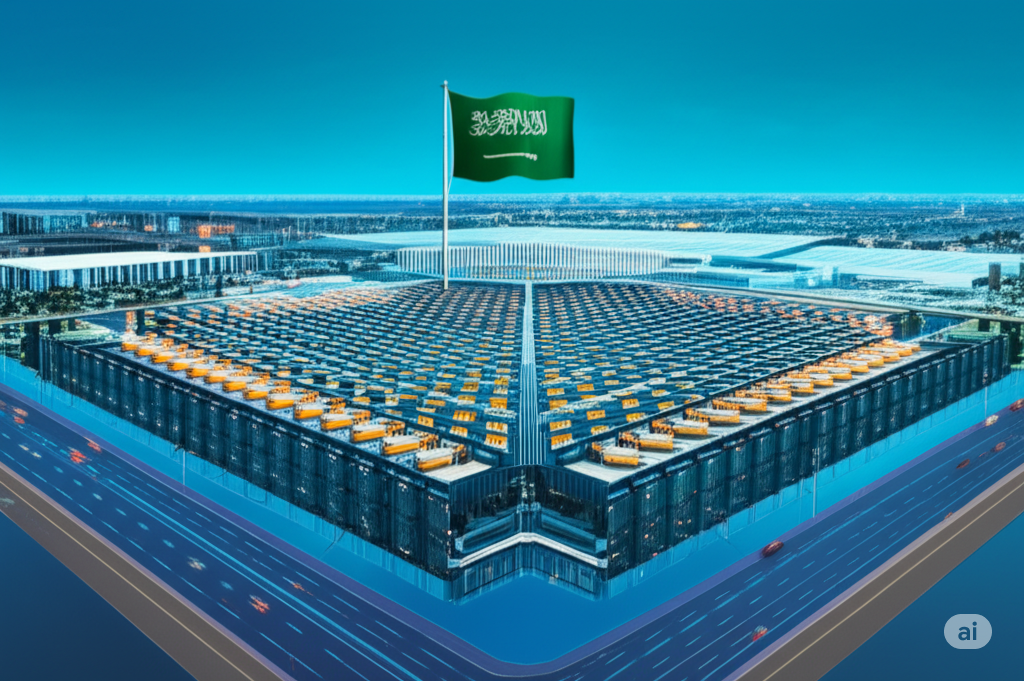Saudi Arabia is making a significant move to establish itself as a major player in the world of Artificial Intelligence. The Kingdom’s newly formed state subsidiary, HUMAIN, has announced a substantial collaboration with tech giant NVIDIA to construct a cutting-edge AI infrastructure, cultivate local talent, and roll out large-scale digital systems.
This ambitious undertaking includes plans to develop AI “factories” powered by an immense 500 megawatts of energy. These facilities will be equipped with NVIDIA’s high-performance GPUs, including the advanced Grace Blackwell GB300 supercomputers interconnected via NVIDIA’s InfiniBand network. The overarching goal is to create a robust foundation for training sophisticated AI models, running complex simulations, and managing large-scale AI deployments entirely within Saudi Arabia.
A key driving force behind this initiative is the desire for control and the establishment of “sovereign AI.” Saudi Arabia aims to develop AI models trained using data, language, and systems specific to the region. By building its own infrastructure, the Kingdom seeks to reduce its reliance on foreign cloud providers, aligning with a growing global trend of governments scrutinizing the development, data handling, and control of AI technologies.
HUMAIN’s structure sets it apart from national AI strategies adopted by other countries. Unlike policy offices or research funds, HUMAIN is designed to operate across the entire AI value chain. This includes building the necessary data centers, managing the vast amounts of data, training the AI models, and ultimately deploying AI-powered applications. This comprehensive approach, under a single entity, is a unique characteristic compared to the more fragmented approaches seen in countries like Singapore and China. Saudi Arabia’s ambition is clear: to become a producer of AI, not just a consumer.
However, this grand vision comes with inherent trade-offs. Operating GPU-intensive data centers on such a massive scale will undoubtedly require significant energy consumption. The planned 500-megawatt capacity far exceeds typical enterprise deployments, raising environmental concerns that are increasingly associated with the global expansion of AI infrastructure. Saudi Arabia will need to articulate how these “AI factories” will be powered, particularly in light of its own sustainability targets outlined in Vision 2030.
Beyond the hardware, the partnership with NVIDIA also encompasses a strong focus on human capital development. HUMAIN and NVIDIA have committed to running extensive education programs aimed at equipping thousands of Saudi developers with crucial skills in AI, robotics, simulation, and digital twins. Building a strong local talent pool is considered essential to fully leverage the new infrastructure and achieve the Kingdom’s AI ambitions.
Jensen Huang, NVIDIA’s founder and CEO, emphasized the strategic importance of AI infrastructure, stating that it is “essential infrastructure for every nation.” He highlighted the collaboration with HUMAIN as a means for Saudi Arabia to realize its bold vision.
One of the key technologies HUMAIN intends to deploy is NVIDIA Omniverse, which will serve as a multi-tenant platform for industries such as logistics, manufacturing, and energy. This will enable these sectors to create digital twins – virtual replicas of real-world systems – for testing, monitoring, and optimizing operations. The core idea is to simulate and refine processes in a digital environment before physical implementation, saving time and resources.
This focus on simulation and optimization aligns with Saudi Arabia’s broader push towards automation and the development of smart industries, fitting into the larger narrative of diversifying its economy beyond oil and embracing advanced technology as a core pillar.
For NVIDIA, this partnership aligns with its global strategy of forging collaborations in key markets, similar to its engagements in India, the UAE, and Europe. Saudi Arabia offers strong governmental backing, substantial funding, and the potential to emerge as a significant AI hub in the Middle East. In return, NVIDIA provides the essential technical foundation – GPUs, software platforms, and the expertise to manage them.
Ultimately, this collaboration appears to be a mutually beneficial arrangement. Saudi Arabia gains the tools and knowledge to build its AI capabilities from the ground up, supporting its economic diversification goals, while NVIDIA secures a significant long-term customer and establishes a strong foothold in a rapidly growing market.
However, several key questions remain. How will HUMAIN govern the use of its AI models? Will they be accessible to researchers and startups, or will they be tightly controlled by the state? What role will local universities and private companies play in this ecosystem? And can the development of a skilled workforce keep pace with the rapid infrastructure buildout?
HUMAIN’s ambitious structure suggests a long-term commitment – a strategic bet linking computational power, national priorities, and a fundamental shift in how AI is developed and deployed. Saudi Arabia’s goal extends beyond mere access to AI; it seeks to gain significant influence in this transformative technological landscape, and HUMAIN, in partnership with NVIDIA, is the powerful engine it is building to achieve that ambition.





